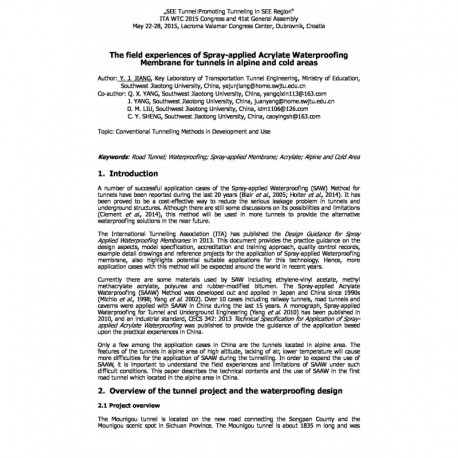Cart
0
0
No document
0,00 €
Total
Document successfully added to your shopping cart
Quantity
Total
There are 0 items in your cart.
There is 1 item in your cart.
Total documents
Total shipping
To be determined
Total
Search & filter
Search for a publication
Search & filter
The field experiences of Spray-applied Acrylate Waterproofing Membrane for tunnels in alpine and cold areas
wtc2015_full_y.j.jiang-1
J. Yang / Y. J. Jiang / Q. X. Yang / D. M. Liu / C. Y. Sheng
A number of successful application cases of the Spray-applied Waterproofing (SAW) Method for tunnels have been reported during the last 20 years (Blair et al., 2005; Holter et al., 2014). It has been proved to be a cost-effective way to reduce the serious leakage problem in tunnels and underground structures. Although there are still some discussions on its possibilities and limitations (Clement et al., 2014), this method will be used in more tunnels to provide the alternative waterproofing solutions in the near future. The International Tunnelling Association (ITA) has published the Design Guidance for Spray Applied Waterproofing Membranes in 2013. This document provides the practice guidance on the design aspects, model specification, accreditation and training approach, quality control records, example detail drawings and reference projects for the application of Spray-applied Waterproofing membrane, also highlights potential suitable applications for this technology. Hence, more application cases with this method will be expected around the world in recent years. Currently there are some materials used by SAW including ethylene-vinyl acetate, methyl methacrylate acrylate, polyurea and rubber-modified bitumen. The Spray-applied Acrylate Waterproofing (SAAW) Method was developed out and applied in Japan and China since 1990s (Michio et al., 1998; Yang et al. 2002). Over 10 cases including railway tunnels, road tunnels and caverns were applied with SAAW in China during the last 15 years. A monograph, Spray-applied Waterproofing for Tunnel and Underground Engineering (Yang et al. 2010) has been published in 2010, and an industrial standard, CECS 342: 2013 Technical Specification for Application of Spray-applied Acrylate Waterproofing was published to provide the guidance of the application based upon the practical experiences in China. Only a few among the application cases in China are the tunnels located in alpine area. The features of the tunnels in alpine area of high altitude, lacking of air, lower temperature will cause more difficulties for the application of SAAW during the tunnelling. In order to expand the use of SAAW, it is important to understand the field experiences and limitations of SAAW under such difficult conditions. This paper describes the technical contents and the use of SAAW in the first road tunnel which located in the alpine area in China.




